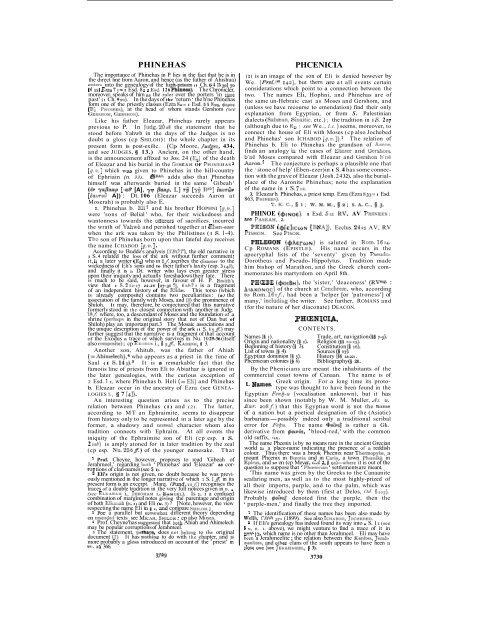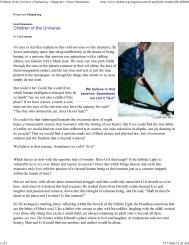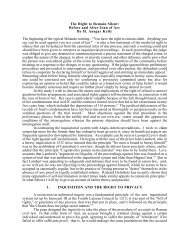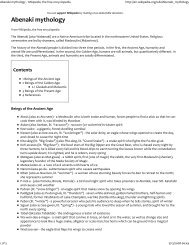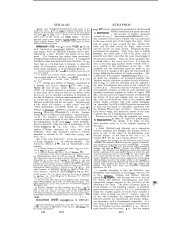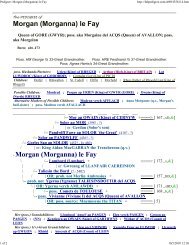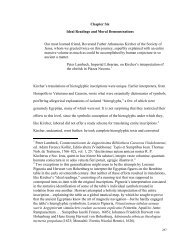Encylodaedia Biblica; a critical dictionary of the literary, political and ...
Encylodaedia Biblica; a critical dictionary of the literary, political and ...
Encylodaedia Biblica; a critical dictionary of the literary, political and ...
You also want an ePaper? Increase the reach of your titles
YUMPU automatically turns print PDFs into web optimized ePapers that Google loves.
PHINEHAS PHCENICIA<br />
The importance <strong>of</strong> Phinehas in P lies in <strong>the</strong> fact that he is in (I) is an image <strong>of</strong> <strong>the</strong> son <strong>of</strong> Eli is denied however by<br />
<strong>the</strong> direct line from Aaron, <strong>and</strong> hence (as <strong>the</strong> fa<strong>the</strong>r <strong>of</strong> Ahishua)<br />
enters into <strong>the</strong> genealogy <strong>of</strong> <strong>the</strong> high- riests (I Ch. 6 4 [5 301 50<br />
We. (ProI.('j 142), but thme are at all events certain<br />
[6 351 Ezra 7 5= I Esd. 8 2 2 Ksd. 126 Phrnees). The Chronicler considerations which point to a connection between <strong>the</strong><br />
moreover, speaks <strong>of</strong> him as <strong>the</strong> ruler over <strong>the</strong> porters 'in tim; two. The names Eli, Hophni, <strong>and</strong> Phinehas are <strong>of</strong><br />
past' (I Ch. 9 20). In <strong>the</strong> days <strong>of</strong> <strong>the</strong> 'return ' <strong>the</strong> h'ne Phinehas <strong>the</strong> same un-Hebraic cast as Moses <strong>and</strong> Gershom, <strong>and</strong><br />
form one <strong>of</strong> <strong>the</strong> priestly classes (Ezra 8 z= I Esd. 5 5 8 29, +pas<br />
[B;, PHIHRES), at <strong>the</strong> head <strong>of</strong> whom st<strong>and</strong>s Gershom (see (unless we have recourse to emendation) find <strong>the</strong>ir only<br />
GERSHOM, GERSHON).<br />
explanation from Egyptian, or from S. Palestinian<br />
Like his fa<strong>the</strong>r Eleazar, Phinehas rarely appears dialects (Sabrean, Sinaitic, etc.) ; <strong>the</strong> tradition in I S. 2 27<br />
previous to P. In Judg.2028 <strong>the</strong> statement that he (although due to RD ; see We., I.c. ) seems, moreover, to<br />
stood before Yahwb in <strong>the</strong> days <strong>of</strong> <strong>the</strong> Judges is no connect <strong>the</strong> house <strong>of</strong> Eli with Moses (cp also Jochebed<br />
doubt a gloss (cp SHILOH) ; <strong>the</strong> whole chapter in its <strong>and</strong> Phinehas' son ICHABOD [q.~.]).' The relation <strong>of</strong><br />
present form is post-exilic. (Cp Moore, Judges, 434, Phinehas b. Eli to Phinehas <strong>the</strong> gr<strong>and</strong>son <strong>of</strong> Aarnn<br />
<strong>and</strong> see JUDGES, 5 13.) Ancient, on <strong>the</strong> o<strong>the</strong>r h<strong>and</strong>, finds an analogy in <strong>the</strong> cases <strong>of</strong> Eliezer <strong>and</strong> tiershoni<br />
is <strong>the</strong> announcement affixed to Jos. 24 (G) <strong>of</strong> <strong>the</strong> death b'ne Moses compared with Eleazar <strong>and</strong> Gershon bne<br />
<strong>of</strong> Eleazar <strong>and</strong> his burial in <strong>the</strong> GIBEAH OF PHINEHAS Aaron.2 The conjecture is perhaps a plausible one that<br />
[q.n.] which wa given to Phinehas in <strong>the</strong> hill-country <strong>the</strong> ' stone <strong>of</strong> help' (Eben-ezer) in I S. 4 has some connec<strong>of</strong><br />
Ephriain (n. 33). @BAL adds also that Phinehas tion with <strong>the</strong> grave <strong>of</strong> Eleazar (Josh. 24 32). also <strong>the</strong> burialhimself<br />
was afterwards buried in <strong>the</strong> same ' Gibeah ' place <strong>of</strong> <strong>the</strong> Aaronite Phinehas; note <strong>the</strong> explanation<br />
(PY yaaaap [-a0 [A], y~ paap, L] TG [yi Bab] law& <strong>of</strong> <strong>the</strong> name in I S. 712.<br />
[baud A]) : Dt. 106 (Eleazar succeeds Aaron at 3. Eleazar b. Phinehas, a priest temp. Ezra (Ezra 8 33= I Esd.<br />
863, PHINEER).<br />
Moserah) is probably also E.<br />
T.K.C.,$I; W.M.M.,$2; S.A.C..§3.<br />
2. Phinehas b. Eli2 <strong>and</strong> his bro<strong>the</strong>r HOPHNI [p.~.]<br />
were 'sons <strong>of</strong> Belial ' who, for <strong>the</strong>ir wickedness <strong>and</strong> PHINOE (+!NO€), I Esd. 531 RV, AV PHIXEES;<br />
wantonness towards <strong>the</strong> <strong>of</strong>f'erers <strong>of</strong> sacrifices. incurred See PASEAH, 2.<br />
<strong>the</strong> wrath <strong>of</strong> Yahwk <strong>and</strong> perished toge<strong>the</strong>r at Eben-ezer<br />
when <strong>the</strong> ark was taken by <strong>the</strong> Philistines (I S. 1-4).<br />
PHISON (+[E]ICWN<br />
PISHON. See PISON.<br />
[BKA]), Ecclus. 2425 AV, RV<br />
Thz son <strong>of</strong> Phinehas born upon that fateful day receives<br />
<strong>the</strong> name ICHABOD [g.u.] .<br />
According to Budde's analysis (SSOT), <strong>the</strong> old narrative in<br />
I S. 4 related <strong>the</strong> loss <strong>of</strong> <strong>the</strong> ark without fur<strong>the</strong>r comment ;<br />
it, is a later writer (E?) who in 2J ascribes <strong>the</strong> disa-ter to <strong>the</strong><br />
wickedness <strong>of</strong> Eli's sons <strong>and</strong> to <strong>the</strong>ir fa<strong>the</strong>r's laxity (esp. 3 146),<br />
<strong>and</strong> finally it is a Dt. writer who lays even greater stress<br />
upon <strong>the</strong>ir iniquity <strong>and</strong> actually foreshadows <strong>the</strong>ir fate. There<br />
is much to be said, however, in favour <strong>of</strong> H. P. Smith's<br />
view that I S. 212.17 22-25 rz7-36 ?I, 416-71 is a fragment<br />
<strong>of</strong> an independent history <strong>of</strong> <strong>the</strong> Elida This torso (which<br />
is already composite) contains two peculiarities : (a) <strong>the</strong><br />
association <strong>of</strong> <strong>the</strong> family with Moses, <strong>and</strong> (6) <strong>the</strong> prominence <strong>of</strong><br />
Shiloh. It may, <strong>the</strong>refore, be conjectured that this narrative<br />
formerly stood in <strong>the</strong> closest connection with ano<strong>the</strong>r in Judg.<br />
1Sl: where, too, a descendant <strong>of</strong> Moses <strong>and</strong> <strong>the</strong> foundation <strong>of</strong> a<br />
shrine (perhap5 in <strong>the</strong> original story that not <strong>of</strong> Dan but <strong>of</strong><br />
Shiloh) play an important part.3 The Mosaic associations <strong>and</strong><br />
<strong>the</strong> unique description <strong>of</strong> <strong>the</strong> power <strong>of</strong> <strong>the</strong> ark (I S. 458) may<br />
fur<strong>the</strong>r suggest that <strong>the</strong> narrative is a fragment <strong>of</strong> that account<br />
<strong>of</strong> <strong>the</strong> Exodus a trace <strong>of</strong> which survives in Nu. 10 29-36 (itself<br />
also coiuposite); cp EXODUS i., $ 5 8 , KADESH, $ 3.<br />
Ano<strong>the</strong>r son, Ahitub, was <strong>the</strong> fa<strong>the</strong>r <strong>of</strong> Ahiah<br />
(=Ahin~elech),~ who appears as a priest in <strong>the</strong> time <strong>of</strong><br />
Saul (I S.143).5 It is a remarkable fact that <strong>the</strong><br />
PHLEaON (@AErWN) is saluted in Rom.1614.<br />
Cp ROMANS (EPISTLE). His name occurs in <strong>the</strong><br />
apocryphal lists <strong>of</strong> <strong>the</strong> 'seventy' given by Pseudo-<br />
Doro<strong>the</strong>us <strong>and</strong> Pseudo- Hippolytus. Tradition made<br />
him bishop <strong>of</strong> Marathon, <strong>and</strong> <strong>the</strong> Greek church commemorates<br />
his martyrdom on April 8th.<br />
PHGBE (+oIBH), <strong>the</strong> 'sister,' 'deaconess' (RVmg. :<br />
AIAKONOC) <strong>of</strong> <strong>the</strong> church at Cenchreae, who, according<br />
to Rom. ISxJ, had been a 'helper [or 'patroness'] <strong>of</strong><br />
many,' includiug <strong>the</strong> writer. See fur<strong>the</strong>r, ROMANS <strong>and</strong><br />
(for <strong>the</strong> nature <strong>of</strong> her diaconate) DEACON.<br />
PHENICIA.<br />
CONTENTS.<br />
Names ($ I).<br />
Trade, art, navigation ($8 7-9).<br />
Origin <strong>and</strong> nationality (5 2). Religion (gp TO-15).<br />
Beginning <strong>of</strong> history ($ 3). Constitution ($ 16).<br />
List <strong>of</strong> towns (g 4). Sources ($5 17).<br />
Egyptian dominion ($ 5). History (Bli 18-22).<br />
Phcenician colonies (5 6). Bibliography ($ 23).<br />
famoiis line <strong>of</strong> priests from Eli to Abiathar is ignored in By <strong>the</strong> Phenicians are meant <strong>the</strong> inhabitants <strong>of</strong> <strong>the</strong><br />
<strong>the</strong> later genealogies, with <strong>the</strong> curious exception <strong>of</strong><br />
2 Esd. 1 I, where Phinehas b. Heli ( =Eli) <strong>and</strong> Phinehas<br />
commercial coast towns <strong>of</strong> Canaan. The name is <strong>of</strong><br />
1. Names. Greek origin. For a long time its protob.<br />
Eleazar occur in <strong>the</strong> ancestry <strong>of</strong> Ezra (see GENEA-<br />
type was thought to have been found in <strong>the</strong><br />
LOGIES i., § 7 [4]).<br />
Egyptian Fen&-u ( vocalisation unknown), hut it has<br />
An interesting question arises as to <strong>the</strong> precise since been shown (notably by W. M. Muller, Ar. u.<br />
relation between Phinehas (I) <strong>and</strong> (2). The latter, EUY. 208J) that this Egyptian word is not <strong>the</strong> name<br />
according to MT an Ephraimite, seems to disappear <strong>of</strong> a nation but a poetical designation <strong>of</strong> <strong>the</strong> (Asiatic)<br />
from history only to be represented in a later age by <strong>the</strong> barbarians-possibly indeed only a traditional scribal<br />
former, a shadowy <strong>and</strong> unreal character whom also error for Fehu. The name Qoivr$ is ra<strong>the</strong>r a Gk.<br />
tradition connects with Ephraim. At all events <strong>the</strong> derivative from @OLY~S, ' blood-red,' with <strong>the</strong> common<br />
iniquity <strong>of</strong> <strong>the</strong> Ephraimite son <strong>of</strong> Eli (cp esp. I S.<br />
2 226) is amply atoned for in later tradition by <strong>the</strong> zeal<br />
(cp esp. Nu.256fl) <strong>of</strong> <strong>the</strong> younger namesake. That<br />
1 Pr<strong>of</strong>. Cheyne, however, proposes to read 'Gibeah <strong>of</strong><br />
Jerahmeel,' regarding both ' Phinehas' <strong>and</strong> 'Eleazar' as corru<br />
tions <strong>of</strong> clan-names (see $ I).<br />
1: Eli's origin is not given, no doubt because he was previously<br />
mentioned in <strong>the</strong> longer narrative <strong>of</strong> which I S. 18 in its<br />
present form is an excerpt. Marq. (Fund. I Z ~ recognises ) <strong>the</strong><br />
traces <strong>of</strong> a double tradition in <strong>the</strong> very full notices given in v. T<br />
(see ELKANAH i., JEROHAM i. SAMUEL). Is ZI. I a confused<br />
combination <strong>of</strong> marginal notes kiving <strong>the</strong> parentage <strong>and</strong> origin<br />
<strong>of</strong> both Elkanah (a. I) <strong>and</strong> Eli (u. 3) ? [Note, however, <strong>the</strong> view<br />
respecting <strong>the</strong> name Eli in B I <strong>and</strong> compare SHII.OH.]<br />
3 For a parallel but somiwhat different <strong>the</strong>ory depending<br />
old suffix, -LK.<br />
The name Phcenix is by no means rare in <strong>the</strong> ancient Grecian<br />
world as a place-name indicating <strong>the</strong> presence <strong>of</strong> a reddish<br />
colour. Thus <strong>the</strong>re was a brook Phcenix near Thermopyk, a<br />
mount Phcenix in Baeotia <strong>and</strong> in Caria, a town Phcenikk in<br />
Epirus, <strong>and</strong> so on (cp Meyer GA 2, $i gzjwhere it is out <strong>of</strong> <strong>the</strong><br />
question to suppose that ' Ptkenician ' settlements are meant.<br />
'This name was given by <strong>the</strong> Greeks to <strong>the</strong> Canaanite<br />
seafaring men, as well as to <strong>the</strong> most highly-prized <strong>of</strong><br />
all <strong>the</strong>ir imports, purple, <strong>and</strong> to <strong>the</strong> palm, which was<br />
likewise introduced by <strong>the</strong>m (first at Delos, Od. 6103).<br />
Probably @obt[ denoted first <strong>the</strong> purple, <strong>the</strong>n <strong>the</strong><br />
' purple-men,' <strong>and</strong> finally <strong>the</strong> tree <strong>the</strong>y imported.<br />
1 The identification <strong>of</strong> <strong>the</strong>se names has been also made by<br />
Wellh. CHPl 371 (1899). See also ICHABOD, JOCHEBED.<br />
on emended texts see MICAH SHILOH ' cp also MOSES.<br />
4 Pr<strong>of</strong>. Cheyne'has suggedd that bdth Ahiah <strong>and</strong> Ahimelech<br />
may be popular corruptions <strong>of</strong> Jerahmeel.<br />
5 The statement, perha s, does not helong to <strong>the</strong> original<br />
document (J). It has notling to do with <strong>the</strong> chapter, <strong>and</strong> is<br />
more probably a gloss introduced on account <strong>of</strong> <strong>the</strong> ' priest' in<br />
zm. 19 366.<br />
3729<br />
2 If Eli's genealogy has indeed found its way into I S. 1 I (see<br />
5 2, n. I, above), we might venture to find a trace <strong>of</strong> it in<br />
mi* 11, which name is no o<strong>the</strong>r than Jerahmeel. Eli may have<br />
been a Jerahmeelite ; <strong>the</strong> relation between <strong>the</strong> Kenites, Jerah-<br />
meelites, <strong>and</strong> &her clans <strong>of</strong> <strong>the</strong> south appears to have heen a<br />
Close One (See JEKAHLIEEL, 5 3).<br />
3730


